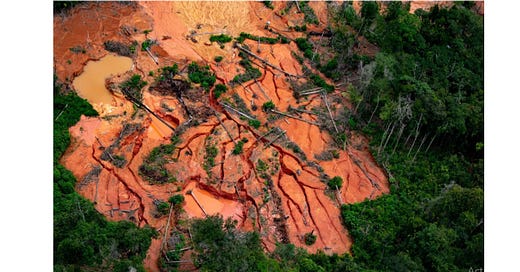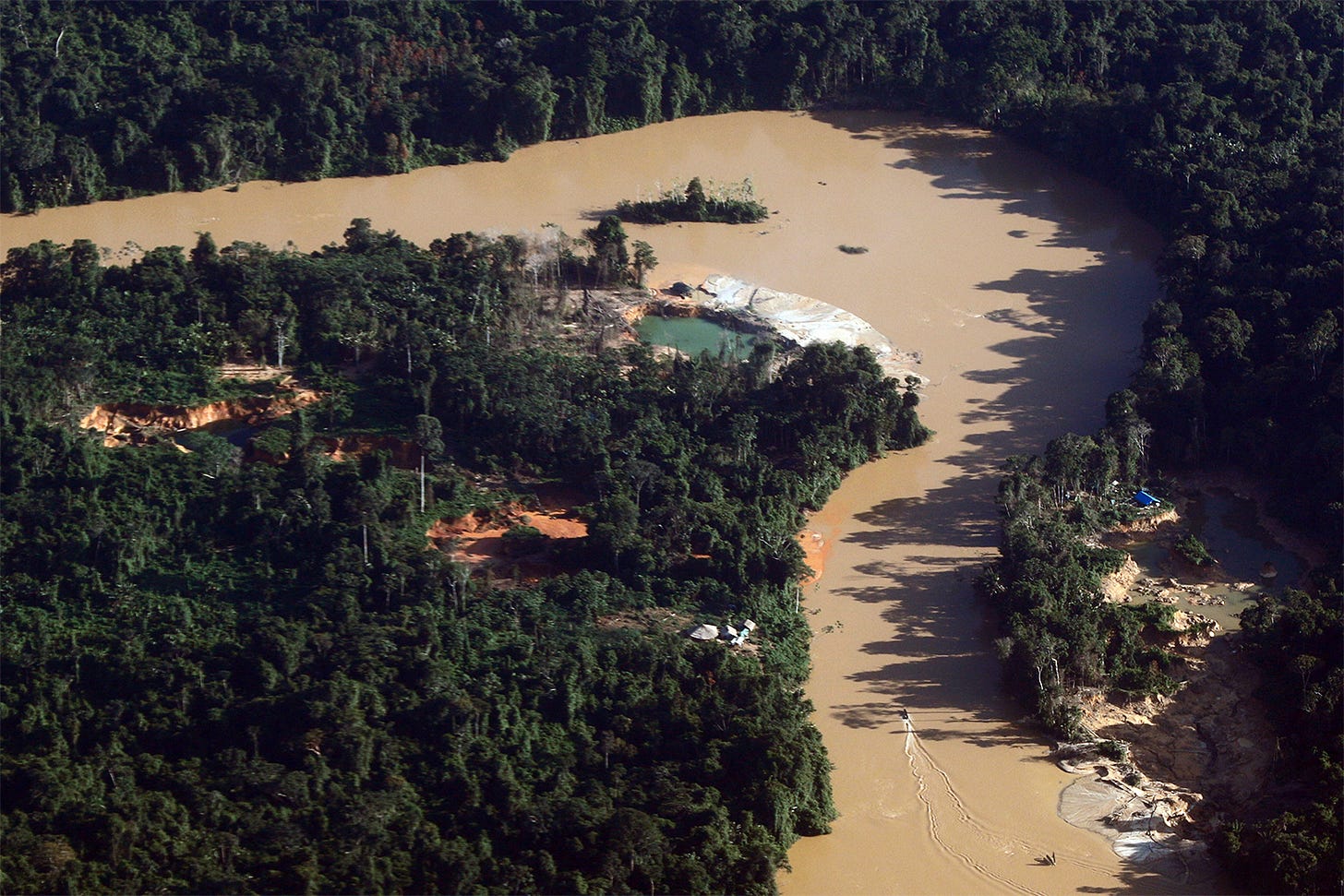Blood Gold and the Yanomami
Gold has always brought out the worst in humanity -- what will it take to be better?
The Yanomami is an indigenous tribe in Brazil, which has inhabited their territory since the beginning of time. Their well-articulated worldview and customs were documented in the 20th century by a spokesperson for the tribe which has become required reading for anthropology students.1 Their lands were invaded in the 1980s by gold miners who brought diseases, toxic pollution, human abuse and conflict to one of the most remote areas of Brazil.
The promise of gold brings out the worst in humanity. The illegal mining of gold on indigenous lands which is illegal under normal circumstances in Brazil, is rampant due to a promise of “good faith” being legally sufficient for gold miners to claim the gold was mined legally.
Recalling some of the worst of humanity was on display when Spanish explorers came to Mexico and Peru in search of gold, in the 16th century. Spain stole tons of gold from the Incas in Peru and the Aztecs in Mexico. The Incas sun god, Inti, was associated with the metal gold, calling it “tears wept by the sun.”2 So there were vast hoards of gold decorating temples and rooms dedicated to the sun god. Spain’s King Ferdinand was desperate for gold, and on July 15, 1511 instructed his explorers to “get gold, humanely, if you can . . .”3
Before the U.S. becomes too condescendingly righteous about Spain’s appalling history of colonization and genocide or Brazil’s violation of human rights, you have only to look back to the 1830s in the state of Georgia to see one of the worst illegal acts of genocide against America’s indigenous people occupying land that was believed to be rich in gold. This thirst for gold by trespassers triggered a capricious President Jackson to ignore the opinion of the US Supreme Court, a test of the very foundation of America, and let gold diggers invade and take over even the houses of the Cherokee Nation people as they were forced onto land far away, making the long walk known as the “trail of tears.” Thus, the twenty dollar bill is a memorial to blood gold and remembering an immoral and unethical President, lest we forget.
The Modern Colonizers
Meanwhile, one-fifth of the indigenous land in the Amazon is occupied by mining,4 much of it gold mining. Gold mining brings mercury contamination of the water and surrounding land. Cyanide is used to recover gold from low-grade ore, and cyanide kills anything alive. When companies do not remediate the land, required by the law in most countries once they are finished, it is left as a poisonous wasteland. This photo of a contaminated river from gold mining running through the Yanomani reserve is dead as a habitat for life.
An aerial photograph shows the impacts of illegal mining activity along the Mucajaí River in Roraima, in the Yanomami Indigenous Territory. Image courtesy of Fernando Frazão/Agência Brasil.
Mercury exposure results in nerve damage, shaking, erratic behavior and inability to walk. The term “mad hatter” describes employees in the hat making industry in the northeast U.S. in the 1890s and 1900s, which required mercury and dermal exposure in the manufacturing process.
In the village of Aracaca, 92% of the people have mercury levels which exceed a safe level.5 This comes not only from water but the entire food web where subsistence fish are highly contaminated from bioaccumulation of mercury in their tissue.
With the defeat of Bolsanaro, the new Brazilian President Luiz Inácio Lula da Silva has taken action to remove illegal gold mining from the Yanomami reservation. Food and medical supplies have been brought in to help the Yanomami recover from the destruction to their subsistence hunting and fishing.6
Brazil’s Constitution
Brazil’s Constitution (1998), Article 231 acknowledges the special status of indigenous lands and the right of Brazil’s Indigenous Peoples to the use and enjoyment of these traditional lands. However, much like the U.S., the Brazilian national government can give permission to mining companies to mine on indigenous land, requiring the approval of their Congress. Brazil requires consultation with tribes and remediation of the land or compensation for damages after the mining is complete. A weak rule of law and lack of enforcement has left damage unremediated and the tribes uncompensated.
But mining illegally on indigenous land has been made easy by the “good faith” provision of a 2013 Brazilian law that allows gold miners to claim their gold was obtained legally based on “good faith”. The Attorney General of Brazil, Augusto Aras, has asked the Brazilian Supreme Court to find this section of the 2013 law unconstitutional because it facilitates illegal mining on indigenous land and gold laundering. Further, legislation was introduced in mid-February to require receipts from miners which would require proof of origin of the gold and compliance with legal mining practices.7
Additionally, there are concerns about the lack of consultation and free, prior, and informed consent (FPIC) of indigenous communities in decision-making processes related to mining and other extractive activities in their territories. Indigenous peoples have the right to participate in decisions that affect their lives and well-being, and their consent is necessary before any such activities can take place in their territories, according to the U.N. Declaration for the Rights of Indigenous Peoples.
National laws throughout the South American continent typically provide Indigenous Peoples with land rights. Only in Guyana do these rights include a limited form of consent for mining. The only country to have the right of first refusal over commercial mining on their territory is Columbia.8 Legal reform protecting the integrity of the natural resources of the Indigenous Peoples of the countries of South America is badly needed.
The DRC Blood Gold
Sixty-five percent of The Democratic Republic of Congo is in the Congo Basin, which is the largest continuous tropical forest in Africa. It is immensely important to the world because it absorbs more carbon than all the forests of the Amazon and Asia combined!9 The Congo Basin is home to one in five species on earth. There is no other place on earth like it. It also happens to be home to some of the purest gold on earth, so the worst of humanity found their way to the Congo.
These gold miners are almost all independent, unregulated and add about 2.3 tons of mercury to the land each year. This is literally killing the earth and destroying this invaluable tropical forest. The good news is that the UN Environmental Program has put in over 10 million dollars to reduce the use of mercury in gold mining, and to require that the gold be exported from Congo, rather than illegally transported across the border to Uganda for export. The gold laundering obscures the origin of the illegal manner in which the gold is extracted from indigenous lands, and by establishing processing facilities in the DRC, there is hope to gain more accountability.10
Global Gold Greed
There are many indigenous tribes around the world whose populations are being devastated by gold mining. Some examples, beginning with the Yanomami, include:
Yanomami: The Yanomami people are one of the largest indigenous tribes in the Amazon rainforest, spanning the border between Brazil and Venezuela. Their lands have been targeted by illegal gold miners who use mercury to extract gold, causing mercury poisoning in the local population.
Ngobe-Bugle: The Ngobe-Bugle people are one of the largest indigenous tribes who live in Panama and Costa Rica. Panama does not recognize indigenous rights and has been accused of violating human and civil rights before the United Nations Commission on Human Rights in 2008. Their lands have been targeted by large-scale gold mining operations, leading to deforestation, water pollution, and displacement of the local population.
Ashaninka: The Ashaninka people are an indigenous tribe who live in Peru and Brazil. Their lands are protected but have been illegally targeted by gold mining operations, leading to deforestation, water pollution, and violent conflict. Some villages have people with blood levels of mercury 34 times the safe limit.11
Penan: The Penan people are an indigenous tribe who live in the Malaysian state of Sarawak on the island of Borneo. Indigenous tribes’ occupational rights are not recognized by the Malaysia government. Their lands have been targeted by large-scale gold mining operations,12 leading to deforestation, water pollution, and displacement of the local population.
Shors: The Shors of the villages of Orton, Ilyinka, Uchas and Trekhrechye located in the Kemerovo region of Siberia have been exploited by illegal geological explorations by Novy Bazas, since 2021. In that short time, they have destroyed agricultural land. In the Askizsky District, cattle grazing, hay gathering and berry and mushroom picking have been destroyed by the Khakassia Gold-Mining Cooperative activities.13
There are many more indigenous tribes around the world that are victims of greed for gold, and we should do better. Cartels that control gold mining in the Congo, and other criminal enterprises that launder gold, are allowed to continue in countries with a weak rule of law often brought on by corruption. Corruption is reduced by transparency and open debate.
The Yanomami serve as a sentinel of humanity where despite their incredible survival through humanity’s history, now their very existence is threatened by the illegal activities of gold mining in their territory. We should not let them down. When the Yanomami are harmed, we are all harmed.
All of us are eventually harmed by blood gold.
[The article voice over is provided by award-winning narrator, Naysan Adlparvar, and sound engineering by Summer Sutton.]
Davi Kopenawa, “The Falling Sky: Words of A Yanomami” (2013) https://www.amazon.com/gp/product/0674724682/
https://www.miningweekly.com/article/spanish-conquistadors-and-the-looting-of-mexican-and-peruvian-golden-treasure-2012-09-07
https://www.miningweekly.com/article/spanish-conquistadors-and-the-looting-of-mexican-and-peruvian-golden-treasure-2012-09-07
https://www.wri.org/research/undermining-rights-indigenous-lands-and-mining-amazon
Study by the Oswaldo Cruz Foundation and Socioenvironmental Institute. https://portal.fiocruz.br/en/news/study-shows-indigenous-amazon-have-their-health-affected-mercury .
https://ictnews.org/news/global-indigenous-traditional-knowledge-depleted-resources-and-well-deserved-recognition
https://www.reuters.com/world/americas/brazil-plans-legislation-crack-down-laundering-illegal-gold-2023-02-16/
https://www.wri.org/research/undermining-rights-indigenous-lands-and-mining-amazon
https://www.nature.com/articles/nature21048
https://www.unep.org/gef/news-and-stories/press-release/congo-miners-step-towards-sustainable-gold-production
https://www.theguardian.com/environment/2013/sep/09/peru-amazon-indigenous-tribe-gold-mining
https://www.mindat.org/locentries.php?m=1720&p=302327
https://goodmenproject.com/featured-content/siberia-gold-mining-is-destroying-the-lands-of-the-indigenous-shor-people/






Thanks for this excellent article. Much more needs to be written about blood gold, and you have laid out excellent information regarding indigenous peoples that have been exploited in the pursuit of gold.
It's long overdue that we put Harriet Tubman on the $20 bill and relegate the Jackson presidential legacy to the genocidal atrocity it was.